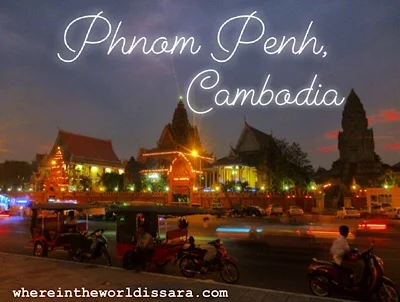Phnom Penh, Cambodia
We left Ho Chi Minh City on a bus headed Northwest to the capital of Cambodia, Phnom Penh (pronounced panom pen). The border crossing was easy with the help of the bus staff organizing passports and visas.

GPS locates us at the Cambodian border
Arriving in the capital, I could tell that there was a lot less people and the city looked more run-down, more trash on the streets and worse roads. Given the history of the country (which I'll go into in a little bit) it's understandable and it's working on developing. I was surprised to find that they mostly use dollars (they use their Cambodian Riel for smaller change) and it seemed like more people spoke English there. There are more beggars and people asking you if you need a tuk tuk ride. So much so that it's annoying to go anywhere, cause you're always being accosted.
Brentwood visited Cambodia many years ago and was familiar with their sad history of genocide in the 1970s. So learning more about it was our main focus. We first went to the Tuol Sleng Genocide Museum which was formerly the Tuol Sleng prison or Security prison 21 (S-21), formerly a high school. We took an audio tour of the grounds where thousands of people were sent to be tortured by the Khmer Rouge regime. Photos of the prisoners, torture devices, cells, and even blood stains on the floors remain. After confession, the prisoners were then sent to Choeung Ek, also known as the killing fields where they met their death. S-21 was the largest prison and it is said that it may have had 20,000 pass through, with only 7 survivors. [Here's a brief summary as to how it all came to pass. On April 17, 1975, the Khmer Rouge forced everyone to leave Phnom Penh and go to the country where they were separated from their families and forced into labor camps. Pol Pot, the Khmer Rouge leader wanted to transform the society into an agrarian one. This lead to killing those identified as intellectuals. The genocide ended in 1979 when the Vietnamese invaded Cambodia and the mass graves and prisons were discovered. In all an estimated 1.5 to 3 million people died from 1975-1979. This is just a brief overview, to learn more google Cambodian Genocide.]

Tuol Sleng Genocide Museum

Interrogation Rules

Barbed wire on the buildings that housed prisoners
The next day we went out to Choeung Ek (formerly a Chinese cemetery) also known as the killing fields where thousands of bodies were uncovered and is now a memorial site. We walked by the sites of the mass graves, the tree which was used to kill children, and could even see bone fragments and clothing still buried in the ground. Every time it rains the staff have to go out and collect the bones and teeth that surface. There is a monument that houses 5000 skulls on display along with other bones and clothing.

Plaque on stupa

Memorial Stupa

Bone & cloth fragments

Inside the memorial stupa
After touring the grounds we went back into town to The Empire moviehouse where they show the movie,
The Killing Fields
everyday at 4. The movie is one person's account of the Cambodian genocide and is pretty intense.
Besides touring depressing places, we visited the central and russian markets, walked along the Mekong River, ate dinner at the Foreign Correspondent's Club, and I kicked a ball around with some kids in front of the grand palace.

View of Phnom Penh from the roof of our hotel

Central Market

Boardwalk along the Mekong River


The kids I kicked the ball around with wanted their picture taken

Kingdom of Cambodia
Cambodia was difficult. As a tourist I felt like a target, someone was always asking for money or to take a tuk tuk ride. Visiting the markets is not a pleasant experience. Everybody is calling out to you to buy something and you feel bad to just ignore them but it's worse if you show the slightest interest and then turn them down-they look sad and dejected. Basically, you can't point, touch, or look at anything without them hounding you to buy, you just have to walk by. I try to keep my head low and smile, constantly saying no thank you. They think that you must be rich if you can travel to another country. That leads to everyone wanting a piece of you or wanting a hand out. It's tough cause you can't give something to everyone, and you don't want to ignore them like a stuck-up person. It's a thin line. I acknowledge that by Cambodian standards I'm not poor but I'm definitely not rich either. If anyone has experience or advice on how to go by interacting, I would gladly hear you out, but from my experience it's difficult.
Next: Siem Reap and Angkor Temples
